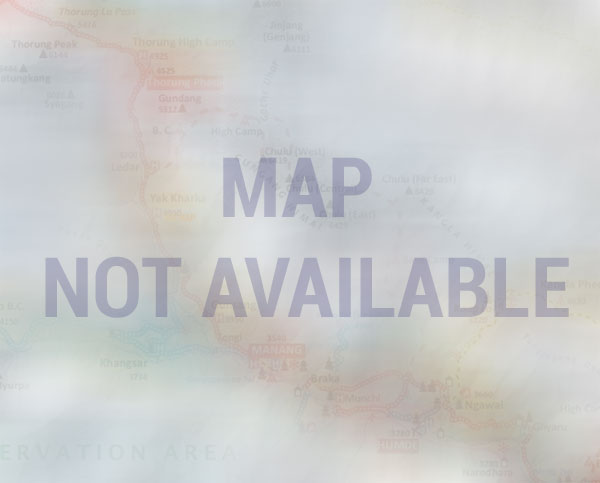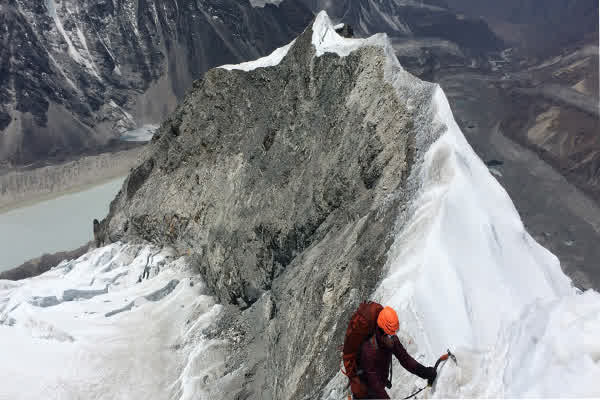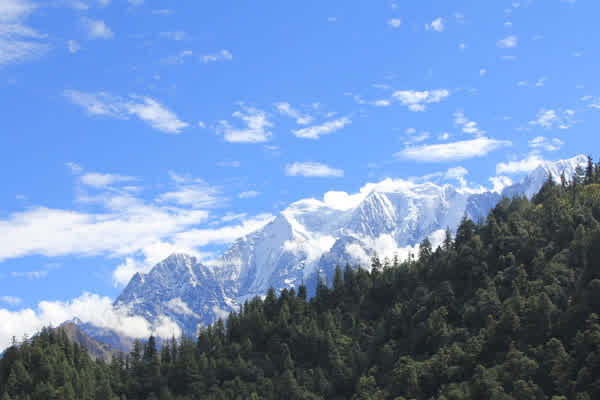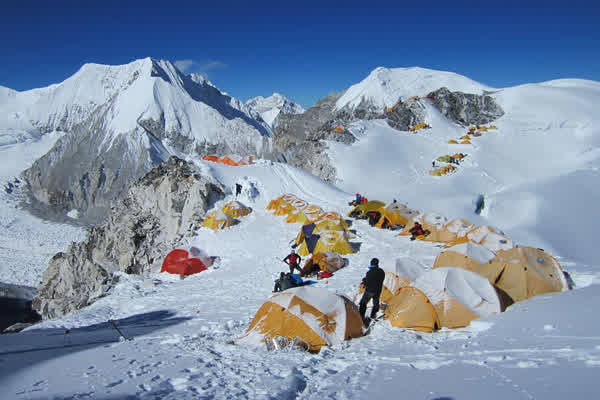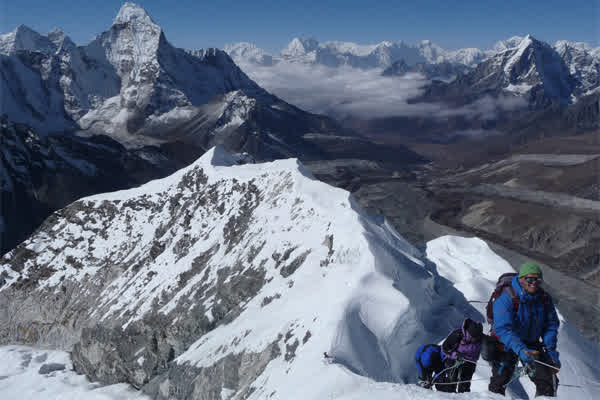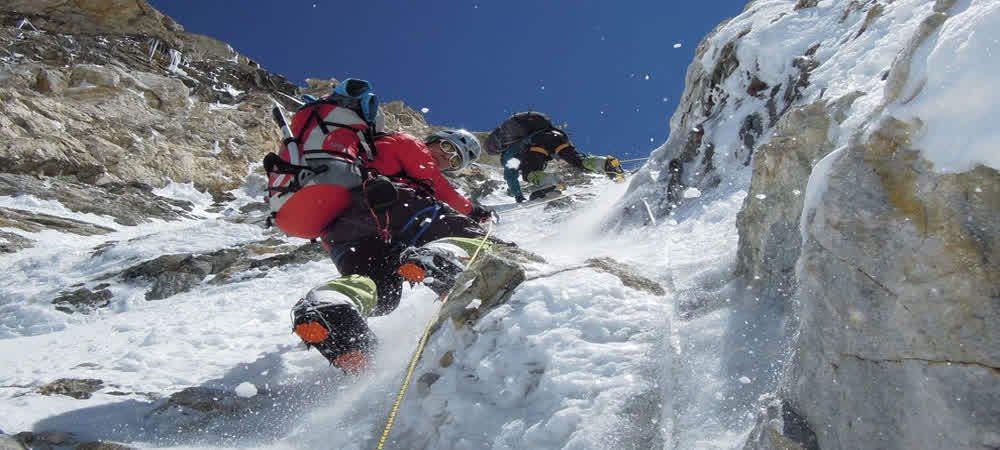
- Overview
- Itinerary
- Price & Dates
- Useful Info
- F.A.Q.
- Gallery
Facts of this Trip
Pisang Peak Climbing
Pisang peak climbing is a short adventurous trekking peak in heart of Annapurna region. It is a famous destination for peak climbing in Nepal. Those who seeking less adventure with few technical difficulties among novice climber in this region.
The itinerary of Pisang peak expediton is compile with certain segement of world leading trekking trail Annapurna circuit trek. Pisang peak is lies in this range, above small beautiful village"Pisang "at Manang District, northern Nepal.
In 1955 a German expedition team made first succession to ascend this peak. After succession of pisang peak climb, then it become highlight a best destination for peak climbing in Nepal or trekking peak in Nepal. Submit offer scenic views of snowcapped Himalayan range with group of snow peak above 6000m. It include world 7th, 8 th and 10th highest mountain in the world Annapurna, Daulagiri, Manaslu with Tilicho, Himchuli, Thorang peak, Gangapurna, chulu east and west, Lamjung Himal and other many more smaller peaks respectively.
Pisang peak climbing is especially for short expedition in nepal. Pisang expediton is normally success wit in 3 days. But the itinerary will be long due to excursion with the world highest pass trek but it is depend upon on the weather condition about the time limitations. It lies opposite of Annapurna II and standing at the majestic height of 6091m in between Annapurna I and Manaslu. Peak climbing itinerary is combination with Round Annapurna trekking on the way to the world longest pass “throng la pass” and the hidden valley or rain shadow area of Nepal Manang and Mustang as well as mini desert also.
Adventure peak climbing and trekking is same trail on Origen and ending of circuit trek in this region across peaceful hamlets. Where we can see crystal clear back ground views of scenic Himalayan range throughout the trail. Which make our day wonderful and enjoyable even we feel tired. Our journey is began drive from Kathmandu to Besishahar on the way to Prithive highway, highway goes on the bank of Tirshuli River. You get an opportunity to see the scenic landscape with farming land on a verities of corps, human settlement and white water rafting on Tirshuli River. While we reach at Beshishar, we start our adventure from here, which is one the main Origen point Pisang peak climbing on heart of this region. The peak climbing expedition offers you a beautiful mountains views, tradition life style, culture of villagers, flora and fauna and many more. After we summit the peak we back to small village and ahead to the Thorang la; it is a longest pass in the world (5416M) and trail continuous to the Muktinath. Muktinath Temple is one of the famous holy destination for both Hindus and Buddhist religion. Then we fly back to Pokhara where our Adventure pisang peak climbing is ends at jomsom.
Best time for peak climbing
The best time for Pisang peak climbing is normally in autumn season start from September to November and spring from March to May is a best season of peak climbing? In this month’s monsoon is over, the sky is clear and climate is sunny and warm in the Himalayas. Thus we can see crystal clear majestic eye catching snowcapped Himalayan range surrounding us in a close distance.
Trip Itinerary
Arrival at Kathmandu arrival
Upon your arrival at the Tribhawn International airport, Kathmandu our representative from Alfresco Adventure Travel wait for you outside at Arrival gate with your Name card. Our team will welcome and collect your baggage at the airport. By formal introduction with the representative and transferred to your hotel. In the evening you will enjoy complimentary welcome dinner in a typical Nepali restaurant with Nepalese cuisine. Overnight at hotel.
Sightseeing at Kathmandu and per trek preparation.
After early morning breakfast, we have sightseeing tour around Kathmandu Valley. Kathmandu valley is well known as living museum, art and cultural hub of the ancient historical city. We visit Swayambhunath Stupa. Swayambhunath stupa is popularly known as monkey temple, which is isolated on a hilltop in Kathmandu and is also one of the famous historical and religious site for both Hindus and Buddhist community. It provides excellent views of the Kathmandu valley. Then we drive to Buddhanath stupa, which is one of the largest stupas in the world and one of the important religious site for Buddhist around the world. Finally, we drive at Pashupatinath Temple is the biggest temple of lord Shiva in south Asia. It is a close distance from Buddhanath Stupa and located at the bank of holy Bagmati River. Pashupatinath Temple is the ultimate pilgrim site for Hindus throughout the world. All those three sites were listed in UNESCO World Heritage sites. Overnight at hotel.
Drive to Besishahar
In the early morning breakfast we drive to Besishahar from Kathmandu along to the partitive Highway. It take approximately 6 to 7 hrs. The highway goes through on the bank of Tishuli River and linkage with many village. You travel make enjoyable by observing the human settlement in different areas, green landscape, farming land with the varieties of crops, waterfalls and you can see the rafting in the Tirshuli River from the highway. The first day we will have short hike through the Gurung village to the Bhulbhule. Overnight at Bhulbhule Tea house
Trek from Bhulbhule to Bhaundanda 1270m
After breakfast we start hike along the Marsyandi River. Today it is easy to walk Beyond it trail accent to towards the uphill Bhaundanda. Overnight at Bhaundanda.
Bhaundanda 1270 to Chyamche 1385m
We start trek while taking breakfast at Bhaundanda then we descend to the Ghermu 1130 m. Today also easy walk ascend towards the Chyamche 1385 m. It takes approximately 5 hours to reach next destination. We enjoy observing a beautiful waterfall and overnight at Chyamche.
Chyamche 1385 m to Danaqyu 2200 m
After breakfast, our trekking is continue to ascend up to Tal village 1700 m, which is located on the bank of Marsyangdi River. We take lunch at Tal village and the flat easy trail heading towards to Danaqyu. We cross Marsyangdi River through the suspension bridge hanging over the river. Around 4 hours of walking, we reach Dharapani. We stop at Dharapani for lunch and a short rest and then we continue our hiking to Danaqyu and Overnight at Danaqyu.
Danaqyu to Cahame 2710m
In the early morning we have a Breakfast with beautiful mountain scenery and we leave Danaqyu. After few hours hike we rest at Bagarchap for a lunch and heading towards Chame. Overnight at Cahame.
Cahame 2710m to upper Pisang 3310m
After the breakfast in this day we start our hike to Upper Pisang from Cahame, It is district headquarter of Manang and. Trekking trail beginning with gentle steep and flat ahead through pine forest and small beautiful Gurung village we cross Suspension Bridge hanging over the Marsyangdi River. Along the trail we get a chance to see an apple farm at Bhratang. After walking 3/4 hours we rest at Dhukurpokhari from here you will get a nice panoramic view of Swargadwari a huge rock formation replicating a huge slide, for lunch and continuous ascending towards upper Pisang. You will see musk deer around the trail. It takes approximately 2/3 hours to reach and overnight at upper Pisang. Then a few minutes rest we visit the monasteries form there, we saw beautiful mountain views of Annapurna II and IV, now you get great experience to see Annapurna facing in your northwest and Marsyangdi River on in your down valley.
Acclimatization
Today is set aside for acclimatization alone. Spending extra time at a high altitude location will guarantee that we have a successful trip. We spend the whole day resting and exploring the village. Exploring the village and interacting with the locals will help us get a better glimpse of the local lifestyle. Throughout the day, the views of Annapurna, Gangapurna and Tilicho are ours to marvel at. Overnight in Upper Pisang.
Upper Pisang to Pisang Peak Base Camp
We begin our trek after breakfast towards the Pisang Base Camp. We ascend on a trail that passes through a thin forest and grasslands. The pasture is used for grazing yaks and is also the best place to set up our camp. The ground is flat and falls on a frequented trail. Overnight at the Pisang Peak Base Camp.
Pisang Peak Base Camp to High Camp
We ascend on the south-west ridge and reach the high camp. After setting up our camp, we participate on a basic climbing training. Our guides will provide training on peak climbing techniques and the proper ways of using climbing gears such as the ice axe, climbing boots and crampons, harness, ascender, etc. The training will also include using ropes to go up and down. Although it is not mandatory to have prior training for Pisang Peak climbing, we strongly believe that some training experience will boost your confidence and climbing skills to increase the chances of scaling the summit as well as to fully enjoy the experience. Overnight at Pisang Peak High Camp.
Summit Pisang Peak and back to base camp
We begin our trek early in the morning after breakfast. Today’s trail will be mostly on rocky surfaces. The peak is steep; therefore, there is not much snow. We will require around 20m of rope to climb on a ridge. Around the summit is around 70 degree of slope which will require the usage of around 200m rope. Both fixed rope and main rope will be used. The views of the Annapurna ranges and others are extraordinary from the summit. We return to the base camp for an overnight stay.
Contingency
This is a separate day reserved for any contingency. If we are not able to summit the Pisang Peak on the day as planned due to bad weather or any unforeseen event, this day can be used.
Pisang Peak Base Camp to Manang Valley
From the base camp of Pisang peak we trek towards Pisang village. From Pisang there are two routes to Manang. We choose the one which passes through Upper Pisang via Geru as it guarantees outstanding views of Mt. Annapurna, Pisang Peak, and others. As we walk near Manang the climate becomes more cold and dry. However, a short visit to Barge Monastery, the biggest monastery in the Manang District should cheer us up. Overnight at Manang.
Manang to Yak Kharka
From Manang village, the trail crosses a stream, climbs to the village of Tenki above Manang, and then continues to climb out of the Marshyangdi Valley turning northwest up the valley of Jarsang Khola. The trail follows this valley northward, passing a few pastures, a scrub of juniper trees, as it steadily gains elevation. The trail further passes near the small village of Ghunsa, a cluster of flat mud roofs just below the trailhead. Now the trail goes through meadows where horses and yaks graze. After crossing a small river on a wooden bridge, the trail passes an ancient old Mani wall in a pleasant meadow and then reaches another small village of Yak Kharka. Small but gradual ascent is the key to avoiding altitude problems.
Yak kharka 4050 m to Thorang la Phedi 4550m
Depend upon you and the prior trek, you have alternative choose to stay today either in Thorang a Phedi or high camp. If you stay in Phedi you have a good sleep rather than the high camp which is situated in lower altitude. However if you stay on high camp you will have an easier trek to next morning but on high altitude it might be quit uneasy for acclimation. Enjoying early morning breakfast and then start your trek for Thorang la Phedi which is lies in the Base of Thorang la Peak. An hour walk from yak kaharka. An hour of trek from Yak Kharka will take us to a village called Ledar. After Ledar, the trail goes flat and easy for some time until we reach a wooden bridge. The area ahead has landslide issues in the rainy season. We will climb uphill to reach Thorong Phedi. Thorong Phedi lies in the Base of Thorong Himal.Trekking above 4,000 meters could prove to be an exhausting experience. The day ends with a trek to Thorang Phedi at the base of Thorong La Pass.
Thorang la phedi 4550 m to Muktinath 3800 m via Thorang la pass 5416 m
This is your dream destination for your trekking. It is the difficulties point of our trekking. Today we cross the Thorang la pass 5416m from the sea level which is the world challenging pass Thorang la pass.it take around 4-5 hours to reach on the tope of Thorang la. Around 4 am early in the morning we start our trekking to cross the first world longest pass Thorang la 5416m. It is easy to us to cross the pass because before 12 noon the pressure of wind is too high so, we cannot easily walk and see our trail because wind carries small stone and tiny sand. When you reach the top then you cannot control your happiness. The whole around is covered by the snow if the weather is good you have some time to play with snow and taking photographs for your lifelong memory. Then we ascending down towards the Muktinath. Muktinath is one of the famous destinations for the religious site as well as religious tour also. It is in the Mustang district which is known as Rain shadow area and Desert of Nepal.
Muktinath 3800 m to Jomsom 2720 m
Early morning hanging around the Ranipauwa” Queens of pilgrim's shelter” known as Muktinath and visit the Muktinath temple, a famous religious site and worshipped by the both for the Hindus and the Buddhists. Today our easy trek goes to downhill to Jomsom following the Kalagandaki River. During the hiking trail offer majesties views of Annapurna and Thkuche mountain ranges. It is headquarter of Mustang District, is the most advanced village in the Round Annapurna and the largest too. In the mid-day strong wind blows in Jomsom. From. Jomsom is also a good place for to buy apple and apple related products.
Early Morning Fly back to Pokhara from Jomsom
Enjoying early morning breakfast in the lap of Himalayan town it is your last day of your early morning breakfast at Himalayan. We have mountain flight back to Pokhara. The flight provide you scenic views of the snow capped mountain range. On the day time is your own you can visit Phewa Lake, Davise fall.
Drive back to Kathmandu from the Pokhara
Our trekking is finished we will be drive back to Kathmandu from beautiful lake city Pokhara. It take around 6-7 hours to reach Kathmandu by Drive. Or you can also travel by Air it will take around 25 minutes.
Transfer to international airport for your onward journey
Today is your last day with us in Nepal. You will escort to the airport for your onward destination with the unforgettable moment of your life from the wonderful Annapurna round with Tilicho Base camp Trek. Our office representative came at your hotel for pick up and drop you at the airport.
Price & Dates
Upcoming Fixed Departure Date and Offer Price.
Trip Cost Includes
- Arrival and Departure by comfortable Private vehicle
- All necessary paperwork, trekking permits, peak climbing permit (National Park Permit, TIMS)
- 3 star accommodation in Kathmandu and pokhara on BB plan (with breakfast)
- Teahouse accommodation during the trek and camping during the peak climbing (Include breakfast, lunch, Dinner)
- Welcome and Farewell dinner in typical Nepal restaurant with Nepal food
- All land transportation is arrange as pre the itinerary in a comfortable vehicle
- City tour in Kathmandu with export guide by private vehicle
- All entrance fees and government and local charges for sightseeing/monument visits as per the itinerary
- An experienced English spoken and government certified climbing guide, trekking guide and assistant trek leader or guide
- Potter service (2 trekkers = 1 porter)
- Staff cost including their salary, insurance and allowance
- Medical kit (carried by your trek leader or guide)
- Climbers’ Certificate (Issued by Government)
- Arrangement of Rescue/Medical Helicopter service; covered by your Insurance agency.
group climbing Gear
-
Rope, Harness, Ice-axe, Carabineers, Crampons
-
F-8, Jumper, Helmet, Ice-Bar, and Ice-screw, Climbing permit
-
Tent, foam mattress, sleeping bags, PAC
-
Bottled Oxygen, Mask etc
Trip Cost Exclude
- Nepalese visa fee
- Excess baggage charge
- Your travel insurance
- Extra night accommodation in Kathmandu and pokhara (because of early arrival, late departure or early return from your trip due to any reason)
- Lunch and evening meals in Kathmandu
- International flight
- Personal Belong items
- Personal expenses, shopping, Beverage bills and so on.
- Tips for staffs
Useful Info
EQUIPMENT
Alpine Climbing Harness – A good climbing harness should be light and simple in design, easy to put on and take off with gloves on, with positively foolproof locking features.
Crampons – Crampons must fit boots perfectly; steel crampons with anti-balling and ability to toe point positively and safely into ice. The lighter the better – extra weight on your feet is much more strenuous than anywhere else on your body.
Ice axe – Ice axe should be versatile and light. A general purpose technical ice axe (T rated) but not too aggressive.
Ascender: Ascender or Jamar, a mechanical device used for ascending on a rope; must be suitable to be used with gloves or mittens. Practice using it with thick gloves on again and again.
Multi-LED Head Lamp – Multi-LED Head Lamp and spare batteries are essential; we do not recommend single bulb lights due to lower reliability.
Carabiners – Minimum 2 locking carabineers, 1 large and 1 small and 4 regular.
Rappel Device – Figure 8, ACT or similar; be familiar with Munter Hitch as it may save your life if you lose your rappel device (which happens a lot)
Trekking Poles – Very handy for the approach; adjustable types are the best (preferably with a simple outside locking mechanism)
Slings – One 3m (10ft) and three 2m (6ft)
Prusik loops – Never hurts to carry a few (e.g. 0.6m and 1.2m), they come in handy in many situations
Masks, hoses, and regulators – Good quality for your safety.
Altimeter – ABC watch or more advanced GPS watches will do the trick. Watch for battery life
Climbing helmet – Climbing helmet is essential safety gear for crossing areas under rocks and ice cliffs; light weight is essential.
CLOTHING
Upper Body
- 1-2 (medium insulation) short-sleeve Merino shirt (e.g. Icebreaker Merino 150 or lightweight
- 200, Odlo Revolution medium)
- 2 long-sleeve Merino shirts (e.g. Icebreaker Merino 150 and/or 200 or Odlo Revolution, one
- medium and one thick)
- One fleece pullover, medium weight.
- One fleece jacket.
- One hard-shell waterproof Gore-Tex jacket with large hood to accommodate the climbing helmet. The Arc’teryx SV range is expensive but offers excellent wind and water protection.
Lightweight down jacket for chilly days in base camp or warm layer when stopping for short breaks. - One very warm expedition grade goose-down (duvet) jacket with hood or a down suit if you prefer, for high altitude use (e.g. North face, Rab etc.)
- Lower Body
- Merino underwear briefs (Icebreaker, Odlo etc.)
- One pair walking shorts Optional
- One pair walking trousers for trekking and around camp
- Two pair thermal Merino bottoms (Icebreaker 150 or 200 or Odlo Revolution)
- One pair very thick thermal Merino bottoms (Icebreaker 200, Odlo Revolution Thick)
- One pair polar fleece trousers or similar mid layer trousers
- One pair Gore-Tex (over)trousers or bibs. Waterproof/breathable with full side zips
- One pair of Goose-down trousers or bibs. You may prefer a down suit (North face, Rab, etc.)
Head
- Warm wool or synthetic hat that covers your ears
- Balaclava or face mask
- Scarf or neck sleeve
- Bandana or head scarf is useful for dusty conditions
- Ball cap or brimmed sun cap
- Glacier Sunglass with side shields (2x)
- One pair of ski goggles (optional with light and dark lens) for windy conditions
Hands
- One pair lightweight liner gloves. These will be worn when tying knots etc.
- Mitten: Goretexovermitts (that block the wind) matched with the very warm down mitts, spare mitts might also be useful (For instance, Mountain Equipment Redline)
Feet
- One pair of plastic boots suitable for >8000m. (For instance La Sportiva Olympus Mons, Millet
- or equivalent good quality plasticshells with inner boots; avoid tight fit with heavy socks)
- One pair sturdy leather or synthetic (Gortex) hiking boots with good ankle support for the walk to base camp
- One pair cross-trainers, running shoes and/or sandals for Kathmandu and in camp
- One pair down booties Optional
- Two pair med-heavy poly or wool socks
- Two Pair of liner socks. Polypropylene or wool
- Vapor barrier liner socks or plastic bread-bags (matter of preference)
- Two pair lightweight trekking socks, poly or wool
- Light Merino wool or cotton socks for in town
Frequently Asked Questions.
Media Gallery
Please click on small photos to have larger view.

